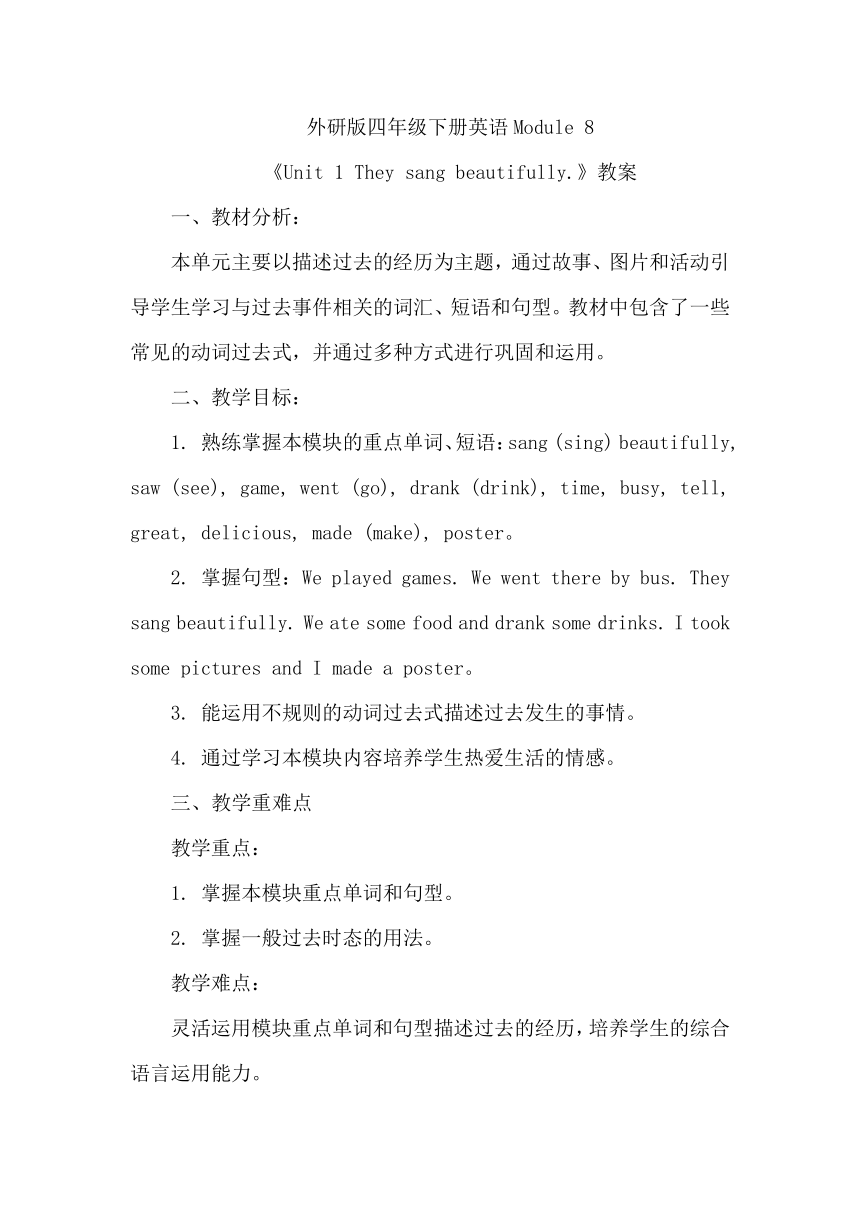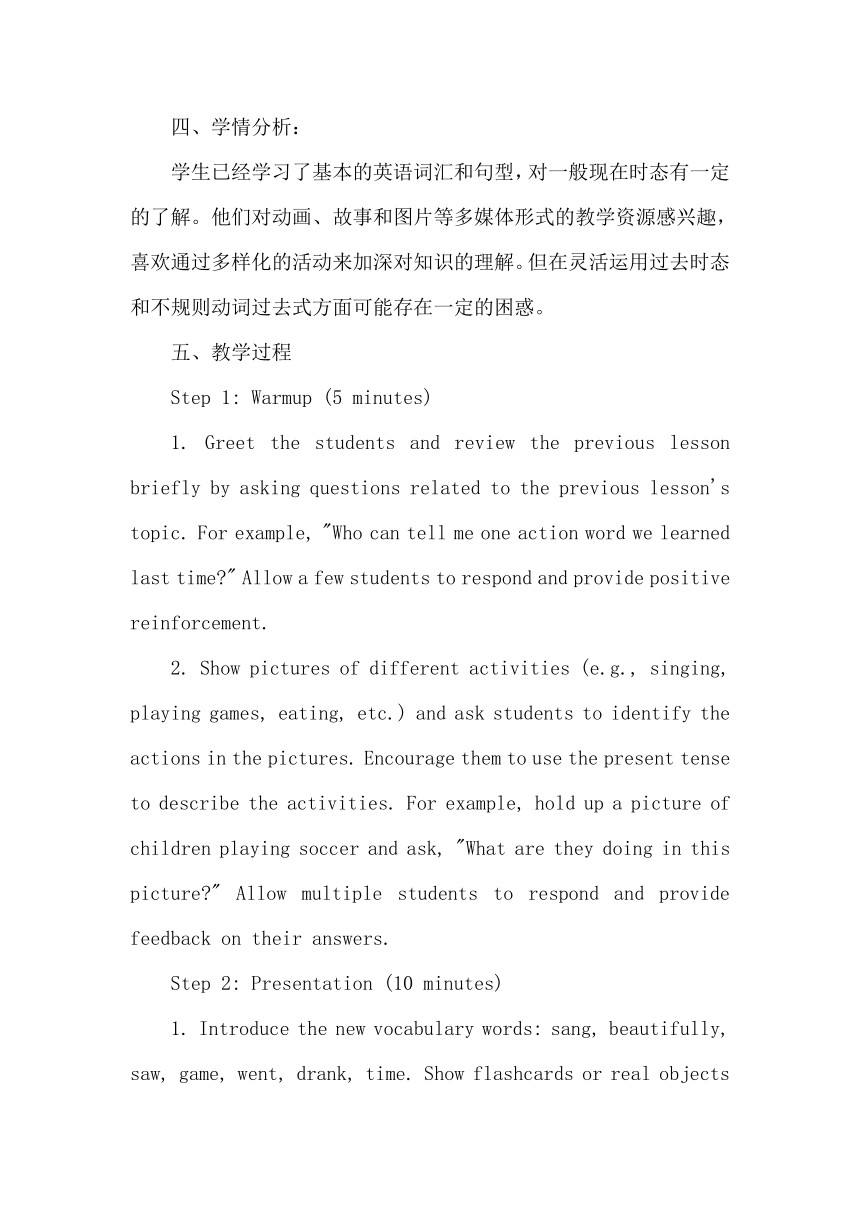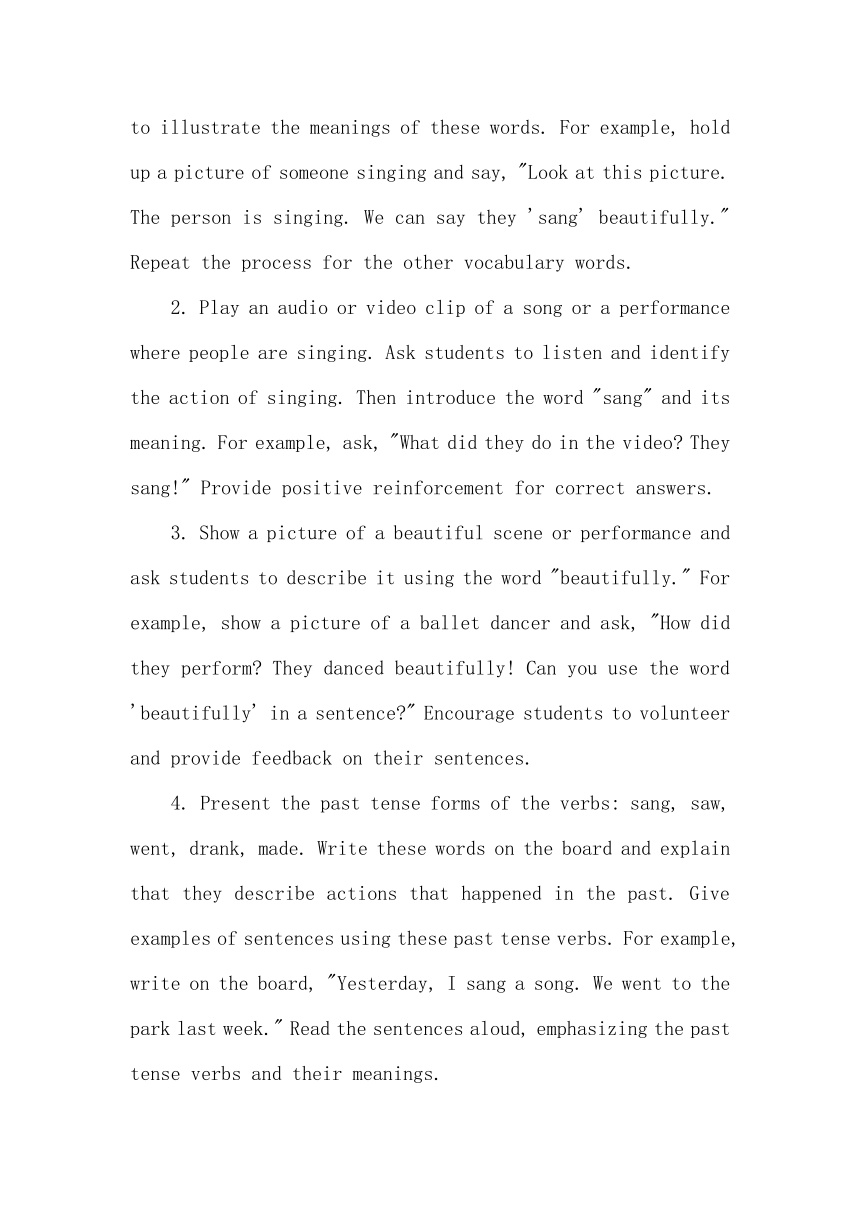Module 8 Unit 1 They sang beautifully 教案
文档属性
| 名称 | Module 8 Unit 1 They sang beautifully 教案 |

|
|
| 格式 | docx | ||
| 文件大小 | 19.0KB | ||
| 资源类型 | 教案 | ||
| 版本资源 | 外研版(三年级起点) | ||
| 科目 | 英语 | ||
| 更新时间 | 2024-06-07 08:24:51 | ||
图片预览



文档简介
外研版四年级下册英语Module 8
《Unit 1 They sang beautifully.》教案
一、教材分析:
本单元主要以描述过去的经历为主题,通过故事、图片和活动引导学生学习与过去事件相关的词汇、短语和句型。教材中包含了一些常见的动词过去式,并通过多种方式进行巩固和运用。
二、教学目标:
1. 熟练掌握本模块的重点单词、短语:sang (sing) beautifully, saw (see), game, went (go), drank (drink), time, busy, tell, great, delicious, made (make), poster。
2. 掌握句型:We played games. We went there by bus. They sang beautifully. We ate some food and drank some drinks. I took some pictures and I made a poster。
3. 能运用不规则的动词过去式描述过去发生的事情。
4. 通过学习本模块内容培养学生热爱生活的情感。
教学重难点
教学重点:
1. 掌握本模块重点单词和句型。
2. 掌握一般过去时态的用法。
教学难点:
灵活运用模块重点单词和句型描述过去的经历,培养学生的综合语言运用能力。
四、学情分析:
学生已经学习了基本的英语词汇和句型,对一般现在时态有一定的了解。他们对动画、故事和图片等多媒体形式的教学资源感兴趣,喜欢通过多样化的活动来加深对知识的理解。但在灵活运用过去时态和不规则动词过去式方面可能存在一定的困惑。
五、教学过程
Step 1: Warmup (5 minutes)
1. Greet the students and review the previous lesson briefly by asking questions related to the previous lesson's topic. For example, "Who can tell me one action word we learned last time " Allow a few students to respond and provide positive reinforcement.
2. Show pictures of different activities (e.g., singing, playing games, eating, etc.) and ask students to identify the actions in the pictures. Encourage them to use the present tense to describe the activities. For example, hold up a picture of children playing soccer and ask, "What are they doing in this picture " Allow multiple students to respond and provide feedback on their answers.
Step 2: Presentation (10 minutes)
1. Introduce the new vocabulary words: sang, beautifully, saw, game, went, drank, time. Show flashcards or real objects to illustrate the meanings of these words. For example, hold up a picture of someone singing and say, "Look at this picture. The person is singing. We can say they 'sang' beautifully." Repeat the process for the other vocabulary words.
2. Play an audio or video clip of a song or a performance where people are singing. Ask students to listen and identify the action of singing. Then introduce the word "sang" and its meaning. For example, ask, "What did they do in the video They sang!" Provide positive reinforcement for correct answers.
3. Show a picture of a beautiful scene or performance and ask students to describe it using the word "beautifully." For example, show a picture of a ballet dancer and ask, "How did they perform They danced beautifully! Can you use the word 'beautifully' in a sentence " Encourage students to volunteer and provide feedback on their sentences.
4. Present the past tense forms of the verbs: sang, saw, went, drank, made. Write these words on the board and explain that they describe actions that happened in the past. Give examples of sentences using these past tense verbs. For example, write on the board, "Yesterday, I sang a song. We went to the park last week." Read the sentences aloud, emphasizing the past tense verbs and their meanings.
Step 3: Practice (15 minutes)
1. Divide the class into small groups and give each group a set of picture cards representing different activities (e.g., playing games, going somewhere, eating, taking pictures, making a poster).
2. In their groups, students take turns picking a picture card and using the past tense to describe what they did in the past. Encourage them to use the target vocabulary and sentence structures. For example, a student picks a card with a picture of friends playing soccer and says, "I played games with my friends. We had a great time!" Encourage other group members to ask followup questions using the past tense. Provide assistance and feedback as needed.
3. Circulate among the groups, listen to their conversations, and provide assistance as needed. Encourage students to use complete sentences and ask followup questions to extend their speaking. For example, if a student says, "I went to the park," ask, "Who did you go with What did you do there " Encourage other group members to contribute to the conversation.
Step 4: Consolidation (10 minutes)
1. Play a memory game with the past tense verbs. Write the verbs on the board and cover them. Remove one cover at a time, and students take turns trying to remember the past tense form and use it in a sentence. For example, reveal the word "drink" and a student says, "Drink, drank. I drank some juice yesterday." Provide positive reinforcement for correct answers and help students if they struggle.
2. Have a class discussion about the students' favorite activities they did in the past. Encourage them to use the target vocabulary and sentence structures. For example, ask, "What games did you play Where did you go What did you eat " Allow multiple students to share their experiences and ask followup questions to encourage further discussion. Provide positive feedback and praise their use of the target language.
Step 5: Application (10 minutes)
1. Assign a task for students to complete individually or in pairs. For example, ask them to write a short paragraph or draw a picture describing a past event using the target vocabulary and sentence structures. Provide sentence starters or prompts if necessary. For example, provide a sentence starter like "Last weekend, I..." or a prompt like "Draw a picture of something you did in the past."
2. Circulate among the students, providing feedback and guidance as they work on the task. Encourage them to use a variety of past tense verbs and descriptive language. Provide positive reinforcement for their efforts and offer suggestions for improvement if needed.
Step 6: Wrapup (5 minutes)
1. Recap the key vocabulary, sentence structures, and grammar points covered in the lesson. Ask students to repeat the past tense verbs and their meanings. For example, say, "Let's review the past tense verbs we learned today. Repeat after me: sang, saw, went, drank, made." Encourage the students to say the words aloud and provide positive reinforcement.
2. Ask a few students to share their paragraphs or pictures with the class. Provide positive feedback and praise their use of the target language. For example, say, "Who would like to share their paragraph or show their picture That's wonderful! I love how you used the past tense verbs and described the event." Give specific compliments to highlight their achievements.
3. End the lesson with a closing remark, such as, "Great job today, everyone! You did an excellent job learning and using the past tense. Keep practicing and using these new words and structures in your everyday conversations. See you next time!"
六、板书设计:
Unit 1: They sang beautifully.
Vocabulary: sang(beautifully), saw (see), game, went (go), drank (drink), time, busy, tell, great, delicious, made (make), poster
Sentence Structures:
We played games.
We went there by bus.
They sang beautifully.
We ate some food and drank some drinks.
I took some pictures and I made a poster.
七、教学反思:
本节课通过多样化的教学活动,引导学生学习和巩固了本模块的重点单词、短语和句型,并运用了一般过去时态描述过去的经历。学生在小组活动中积极参与,展示了一定的语言运用能力。然而,对于不规则动词过去式的记忆和运用仍然存在一定的挑战。在今后的教学中,可以通过更多的练习和复习来帮助学生巩固所学内容,并鼓励他们在实际生活中运用英语来描述过去的经历,以提高他们的语言表达能力。
《Unit 1 They sang beautifully.》教案
一、教材分析:
本单元主要以描述过去的经历为主题,通过故事、图片和活动引导学生学习与过去事件相关的词汇、短语和句型。教材中包含了一些常见的动词过去式,并通过多种方式进行巩固和运用。
二、教学目标:
1. 熟练掌握本模块的重点单词、短语:sang (sing) beautifully, saw (see), game, went (go), drank (drink), time, busy, tell, great, delicious, made (make), poster。
2. 掌握句型:We played games. We went there by bus. They sang beautifully. We ate some food and drank some drinks. I took some pictures and I made a poster。
3. 能运用不规则的动词过去式描述过去发生的事情。
4. 通过学习本模块内容培养学生热爱生活的情感。
教学重难点
教学重点:
1. 掌握本模块重点单词和句型。
2. 掌握一般过去时态的用法。
教学难点:
灵活运用模块重点单词和句型描述过去的经历,培养学生的综合语言运用能力。
四、学情分析:
学生已经学习了基本的英语词汇和句型,对一般现在时态有一定的了解。他们对动画、故事和图片等多媒体形式的教学资源感兴趣,喜欢通过多样化的活动来加深对知识的理解。但在灵活运用过去时态和不规则动词过去式方面可能存在一定的困惑。
五、教学过程
Step 1: Warmup (5 minutes)
1. Greet the students and review the previous lesson briefly by asking questions related to the previous lesson's topic. For example, "Who can tell me one action word we learned last time " Allow a few students to respond and provide positive reinforcement.
2. Show pictures of different activities (e.g., singing, playing games, eating, etc.) and ask students to identify the actions in the pictures. Encourage them to use the present tense to describe the activities. For example, hold up a picture of children playing soccer and ask, "What are they doing in this picture " Allow multiple students to respond and provide feedback on their answers.
Step 2: Presentation (10 minutes)
1. Introduce the new vocabulary words: sang, beautifully, saw, game, went, drank, time. Show flashcards or real objects to illustrate the meanings of these words. For example, hold up a picture of someone singing and say, "Look at this picture. The person is singing. We can say they 'sang' beautifully." Repeat the process for the other vocabulary words.
2. Play an audio or video clip of a song or a performance where people are singing. Ask students to listen and identify the action of singing. Then introduce the word "sang" and its meaning. For example, ask, "What did they do in the video They sang!" Provide positive reinforcement for correct answers.
3. Show a picture of a beautiful scene or performance and ask students to describe it using the word "beautifully." For example, show a picture of a ballet dancer and ask, "How did they perform They danced beautifully! Can you use the word 'beautifully' in a sentence " Encourage students to volunteer and provide feedback on their sentences.
4. Present the past tense forms of the verbs: sang, saw, went, drank, made. Write these words on the board and explain that they describe actions that happened in the past. Give examples of sentences using these past tense verbs. For example, write on the board, "Yesterday, I sang a song. We went to the park last week." Read the sentences aloud, emphasizing the past tense verbs and their meanings.
Step 3: Practice (15 minutes)
1. Divide the class into small groups and give each group a set of picture cards representing different activities (e.g., playing games, going somewhere, eating, taking pictures, making a poster).
2. In their groups, students take turns picking a picture card and using the past tense to describe what they did in the past. Encourage them to use the target vocabulary and sentence structures. For example, a student picks a card with a picture of friends playing soccer and says, "I played games with my friends. We had a great time!" Encourage other group members to ask followup questions using the past tense. Provide assistance and feedback as needed.
3. Circulate among the groups, listen to their conversations, and provide assistance as needed. Encourage students to use complete sentences and ask followup questions to extend their speaking. For example, if a student says, "I went to the park," ask, "Who did you go with What did you do there " Encourage other group members to contribute to the conversation.
Step 4: Consolidation (10 minutes)
1. Play a memory game with the past tense verbs. Write the verbs on the board and cover them. Remove one cover at a time, and students take turns trying to remember the past tense form and use it in a sentence. For example, reveal the word "drink" and a student says, "Drink, drank. I drank some juice yesterday." Provide positive reinforcement for correct answers and help students if they struggle.
2. Have a class discussion about the students' favorite activities they did in the past. Encourage them to use the target vocabulary and sentence structures. For example, ask, "What games did you play Where did you go What did you eat " Allow multiple students to share their experiences and ask followup questions to encourage further discussion. Provide positive feedback and praise their use of the target language.
Step 5: Application (10 minutes)
1. Assign a task for students to complete individually or in pairs. For example, ask them to write a short paragraph or draw a picture describing a past event using the target vocabulary and sentence structures. Provide sentence starters or prompts if necessary. For example, provide a sentence starter like "Last weekend, I..." or a prompt like "Draw a picture of something you did in the past."
2. Circulate among the students, providing feedback and guidance as they work on the task. Encourage them to use a variety of past tense verbs and descriptive language. Provide positive reinforcement for their efforts and offer suggestions for improvement if needed.
Step 6: Wrapup (5 minutes)
1. Recap the key vocabulary, sentence structures, and grammar points covered in the lesson. Ask students to repeat the past tense verbs and their meanings. For example, say, "Let's review the past tense verbs we learned today. Repeat after me: sang, saw, went, drank, made." Encourage the students to say the words aloud and provide positive reinforcement.
2. Ask a few students to share their paragraphs or pictures with the class. Provide positive feedback and praise their use of the target language. For example, say, "Who would like to share their paragraph or show their picture That's wonderful! I love how you used the past tense verbs and described the event." Give specific compliments to highlight their achievements.
3. End the lesson with a closing remark, such as, "Great job today, everyone! You did an excellent job learning and using the past tense. Keep practicing and using these new words and structures in your everyday conversations. See you next time!"
六、板书设计:
Unit 1: They sang beautifully.
Vocabulary: sang(beautifully), saw (see), game, went (go), drank (drink), time, busy, tell, great, delicious, made (make), poster
Sentence Structures:
We played games.
We went there by bus.
They sang beautifully.
We ate some food and drank some drinks.
I took some pictures and I made a poster.
七、教学反思:
本节课通过多样化的教学活动,引导学生学习和巩固了本模块的重点单词、短语和句型,并运用了一般过去时态描述过去的经历。学生在小组活动中积极参与,展示了一定的语言运用能力。然而,对于不规则动词过去式的记忆和运用仍然存在一定的挑战。在今后的教学中,可以通过更多的练习和复习来帮助学生巩固所学内容,并鼓励他们在实际生活中运用英语来描述过去的经历,以提高他们的语言表达能力。
同课章节目录
- Module 1
- Unit 1 She's a nice teache
- Unit 2 He's cool.
- Module 2
- Unit 1 London is a big city.
- Unit 2 It's very old.
- Module 3
- Unit 1 Robots will do everything.
- Unit 2 On Monday I'll go swimming.
- Module 4
- Unit 1 Will you take your kite?
- Unit 2 Will it be hot in Haikou?
- Module 5
- Unit 1 I was two then.
- Unit 2 They were young.
- Module 6
- Unit 1 Were you at home yesterday?
- Unit 2 Was it a big city then ?
- Module 7
- Unit 1 I helped Mum.
- Unit 2 Grandma cooked fish.
- Module 8
- Unit 1 They sang beautifully.
- Unit 2 I took some pictures.
- Module 9
- Unit 1 Did he live in New York ?
- Unit 2 Did you have a nice holiday?
- Review Module
- Unit 1
- Unit 2
- Module 10
- Unit 1 Did you fall off your bike?
- Unit 2 Sam had lots of chocolate.
